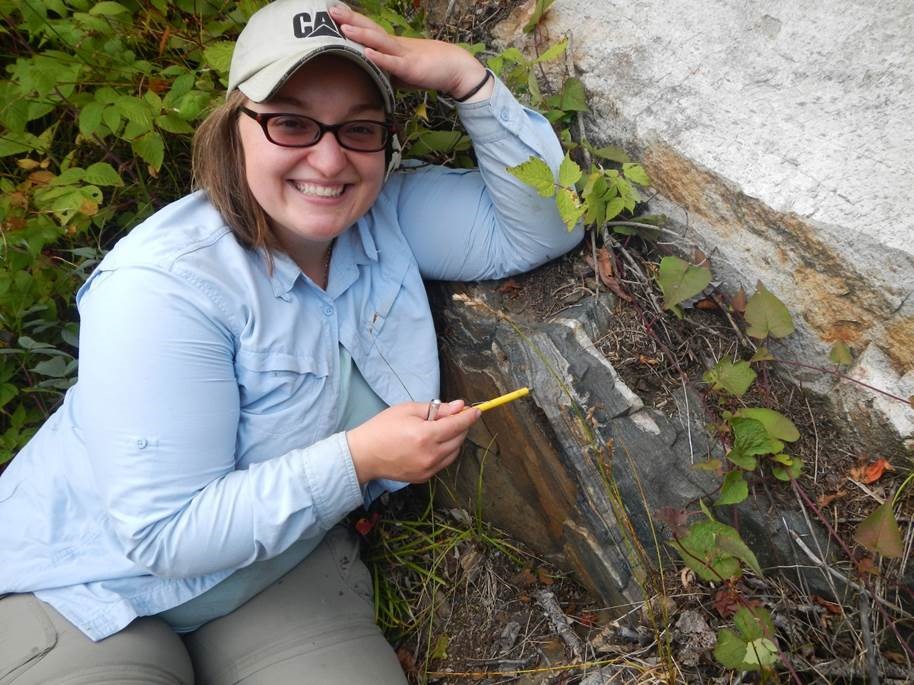
USask graduate to serve as geologist-in-residence at national park
Dr. Victoria Stinson (PhD’22) will conduct field work and host tours in Pukaskwa National Park through a new Canadian Federation of Earth Sciences program
By Shannon Boklaschuk
A University of Saskatchewan (USask) graduate will make history this month when she brings her scientific knowledge to a national park as the first Canadian Federation of Earth Sciences (CFES) geologist-in-residence.
“It is an enormous opportunity and responsibility,” said Dr. Victoria Stinson (PhD’22), who studied in the Department of Geological Sciences in USask’s College of Arts and Science and currently lives in Thunder Bay, Ont.
“Teaching, mentoring and field work are my greatest passions, and this combines all of them,” she said.
The Geologist-in-Residence Program was developed by the CFES and is being offered for the first time this summer through a partnership with Parks Canada. The CFES, which was established in 2006 as the successor to the Canadian Geoscience Council, is an umbrella organization that represents a federation of Earth science societies and associations across Canada.
Stinson said “many exceptional geologists across Canada” applied for the opportunity, which is available to an Earth science specialist or communicator, a practicing or retired geologist, or an upper-level post-secondary student studying geoscience at a Canadian university. The geologist-in-residence will engage in a two-week residency serving as a Parks Canada volunteer who educates visitors and staff about the geological formations and phenomena in the park. More information is available on the CFES website.
“Thanks to a new partnership with Parks Canada, Pukaskwa National Park will be hosting the first geologist-in-residence in Canadian history,” said Courtney Onstad (BSc’18, MSc’21), a USask geology graduate who studied in the College of Arts and Science alongside Stinson and serves as the communications director for the CFES. “The pilot program will allow Dr. Stinson to interact with park visitors through drop-in sessions, geology hikes and even through social media. We hope the program will demonstrate the value that geologists can add to Canada’s national parks.”
“Pukaskwa National Park is proud to partner with the Canadian Federation of Earth Sciences for the first Geologist-in-Residence Program,” said Amy Mackie, acting park superintendent. “Pukaskwa National Park is known for its rugged landscape, but few know the story of how that landscape was formed. This is a wonderful learning opportunity to know more about the geological processes that have shaped the shoreline of northern Lake Superior.”
Members of the public can follow Stinson’s journey as geologist-in-residence on social media, through Twitter, LinkedIn, Facebook and Instagram. Visitors to Pukaskwa National Park in Ontario will also be able to share their own photos on social media using the #PukaskwaGeo hashtag.
As a PhD student at USask, under the supervision of Dr. Yuanming Pan (PhD), Stinson began studying how ancient metamorphic rocks are exposed at Earth’s surface and mined for gold. Her research, which was funded by the Natural Sciences and Engineering Research Council of Canada (NSERC), quickly expanded to include the entire Canadian Shield. Pukaskwa National Park transects with Stinson’s PhD field study area.
Stinson said she was inspired to pursue post-secondary education in science, including her doctoral degree in geology, after spending time in nature with her family in Northwestern Ontario.
“I had many Earth science questions that no one could answer during my childhood and wanted to find the answers,” she said.
Stinson has previous experience working in mines and developing university-level geology curricula, and is currently a manager at the Métis Nation of Ontario in the Lands, Resources and Consultations Branch. She will now add geologist-in-residence to her resume when she joins Parks Canada staff at Pukaskwa National Park from Aug. 15 – 29.
Stinson, who received her PhD during USask’s Spring Convocation earlier this year, said geologists can help Canadians learn more about their national parks by explaining how the natural world formed over deep time. She described Pukaskwa National Park as “a natural treasure” overlooking Lake Superior. The geological history of the park spans billions of years but, due to its complexity, it has been historically understudied, she said.
As the geologist-in-residence, Stinson plans to conduct field work in the park and provide her findings to members of the public and to Parks Canada staff through guided hiking tours. She will include the public in the field work as “citizen scientists.”
“I will also be offering drop-in sessions so that the public and staff can have a face-to-face opportunity to ask questions about the geology of the park and other scientific questions,” she said. “These will provide opportunities to spark appreciation for nature and improve scientific literacy.”
Stinson noted that the COVID-19 pandemic has demonstrated the value of improving scientific literacy in Canada, and initiatives such as the new CFES Geologist-in-Residence Program can play a key role in helping people to better understand the world around them.


